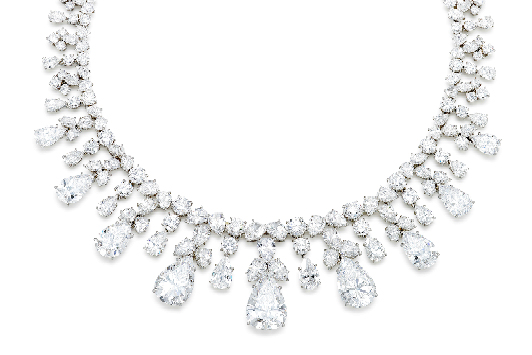 Image: Sotheby's
Image: Sotheby's
Cryptocurrencies have been finding their way into the diamond business, creating opportunities for market growth. Yet many traders resist using these unregulated, volatile forms of coinage, which continue to face resistance from authorities.
An important development occurred recently when Sotheby’s announced it would accept payment in Bitcoin or Ether at some Hong Kong diamond auctions. Shortly afterward, at a Sotheby’s sale in July, a crypto buyer purchased a pear-shaped, 101.38-carat, D-flawless diamond for $12.3 million.
“Digital transformation is accelerated by the pandemic, and Asian collectors have been fast to adapt, leading to exponential growth in online auctions — so it makes sense for us to provide this platform for our growing online clientele,” explained Wenhao Yu, deputy chairman of jewelry for Sotheby’s in Asia.
In late September, however, Chinese regulators cracked down on the use of cryptocurrencies, with a blanket ban on all digital-money transactions. The situation was still developing as of press time, and it remains unclear how it will affect the market.
Security measures
Meanwhile, the wider diamond trade is watching with interest as crypto transactions increasingly gain acceptance. However, industry members are wary of the risks that stem from the unregulated nature of cryptocurrencies, which can fluctuate sharply against more established currencies. Companies will need to adopt rigorous anti-money laundering and know-your-customer (KYC) measures if they want to be able to trade with trust.
Neil Ventura of De Beers believes the diamond industry should seek to understand the disruptive innovations that cryptocurrencies will bring.
“While in the past, the diamond sector may have taken a more insular approach to developments in other fields, the industry has come a long way and is now much more alive to monitoring outside activities,” says Ventura, who serves as the company’s executive vice president of strategy and innovation. “We at De Beers see this as a prudent approach. Ignoring something with such potential to have an impact on the global financial sector would simply mean increasing the potential of missing opportunities or being slow to respond to risks.”
The development of blockchain and cryptocurrencies can deliver a range of reputational, operational and commercial benefits along the supply chain, he adds. Not only can these technologies help establish new levels of trust, they may drive faster transactions and transfer of ownership, reducing counterparty risk.
Opening doors
Another aspect of trading with cryptocurrencies is the impact they may have on demand for diamonds.
“A lot of consumers have increased their disposable income in the crypto world, and it’s a market worth tapping into — if not now, eventually,” says Harsh Kunming, director of supplier Kunming Diamonds.
However, he warns, there are pitfalls. “There are a lot of scams, and many people globally have lost a lot of money due to cyber hacking, so it’s important to educate yourself and be prepared for what the millennials and a lot of prominent financial experts believe will be the next financial revolution.”
One way or another, it would benefit the diamond trade to keep abreast of that revolution, according to Ventura. “With crypto starting to enter [the] mainstream, consumers are starting to gain more familiarity. It remains to be seen how this might play out, particularly as regulation starts to kick in, but we think it’s important to maintain an analytical eye on such significant developments in the finance and tech fields.”
Article from the Rapaport Magazine - October 2021. To subscribe click here.